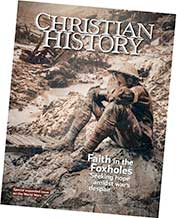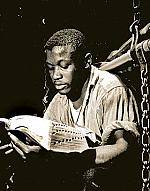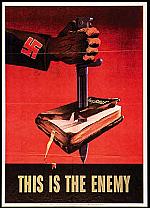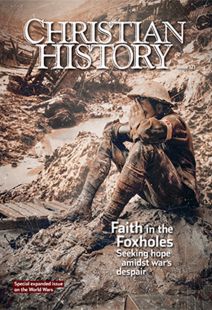Services in leaky tents
FOR BAPTIST MINISTER C. C. Bateman, serving as a military chaplain turned him into “a spiritual sportsman [who] could use fishing tackle or exercise his use of the Gospel gun as a wing shot.” While chaplains did not carry weapons, Bateman’s metaphor was apt, for military clergy had to adapt to new circumstances quickly. World War I forced the military chaplaincy to refashion itself into a new organization: larger, more mobile, and more diverse than ever before.
Order Christian History #121: Faith in the Foxholes in print.
Subscribe now to get future print issues in your mailbox (donation requested but not required).
In April 1917 American military chaplains numbered only 146 (army) and 40 (navy). The army chaplaincy expanded to 2,230 men (including 63 African Americans), and the navy quintupled to 201 over 18 months of war. The ministers who donned Uncle Sam’s uniform in the Great War had to fulfill three specific duties: lead worship services, bury the dead according to the soldiers’ religious traditions, and provide language and literacy instruction.
Bible classes under the sky
Ministry in combat, most new chaplains learned, was quite different from preaching at home. First there was physical hardship. Chaplain G. W. Weldon mused, “We used tallow candles when we could get them, carried our own water, waded through mud, held services in a leaky tent, taught Bible classes in their company streets with the sky for shelter.” Those same obstacles could bring pleasure too—unit camaraderie after an exhausting day and stargazing during quiet nights.
Second, the war was unnerving; church services in the field often amplified the terror. One chaplain reported huddling with a handful of soldiers while conducting worship as an aerial dogfight—a new technique of close-range airplane-to-airplane combat—raged overhead. No matter the circumstances, chaplains provided spiritual nourishment in hard times.
For many chaplains religious cooperation endured as one of the greatest pleasures and accomplishments of wartime service. Unlike the denominationally segregated home front, chaplains ministered to multifaith and multidenominational units. This invigorated many and became the stuff of wartime lore. “So there you have it,” Chaplain Frank Wilson concluded one report, “the Jewish Feast of Purim, celebrated by American soldiers in Italy, in a Young Men’s Christian Association hut, addressed by an Episcopalian chaplain, refreshments being furnished by the Red Cross society, and cigarettes donated by the Roman Catholic Knights of Columbus.”
Over and over again, chaplains repeated tales of accomplishment in war’s wilderness: crafting novel worship services in strange venues, discovering how to pastor men of many different backgrounds, and welcoming the opportunity to encourage faith through rituals other than their own.
This article is from Christian History magazine #121 Faith in the Foxholes. Read it in context here!
By Ronit Y. Stahl
[Christian History originally published this article in Christian History Issue #121 in 2017]
Ronit Y. Stahl, fellow in the Department of Medical Ethics and Health Policy at the University of Pennsylvania and author of Enlisting Faith: How the Military Chaplaincy Shaped Religion and State in Modern America.Next articles
Christian History timeline: World Wars
In the space of just over three decades, large portions of the world were plunged into life-changing conflict
Support us
Christian History Institute (CHI) is a non-profit Pennsylvania corporation founded in 1982. Your donations support the continuation of this ministry
Donate







